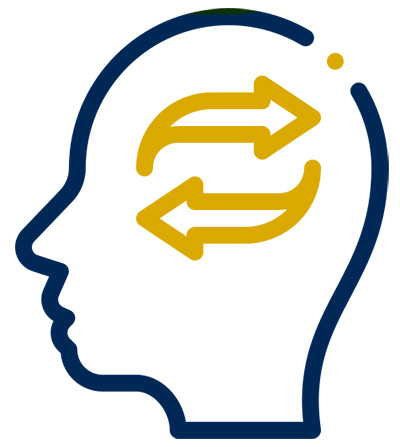Have you ever had a problem in work or life that you were stuck on? Perhaps it was a behavior that you couldn’t start or stop doing. Or maybe it had to do with your relationship or communication with another person and you just couldn’t figure out how to change your own behavior, your own response to the problem or couldn’t influence the situation to be more positive. This week, we are going to discuss five different lenses, originally used by anthropologist Gregory Bateson’s research on neurological levels, to help us explore how to find a pathway forward that works for us.
 We can use these lenses to best identify how to intervene on our own problems or goals. These lenses are intertwined and influence each other, so the goal is to identify where we want to intervene to solve the problem, then align the rest of the lenses with that intervention. The lenses are Identity, Beliefs, Abilities, Behaviors or Actions and Environment. Let’s take a look at these more closely.
We can use these lenses to best identify how to intervene on our own problems or goals. These lenses are intertwined and influence each other, so the goal is to identify where we want to intervene to solve the problem, then align the rest of the lenses with that intervention. The lenses are Identity, Beliefs, Abilities, Behaviors or Actions and Environment. Let’s take a look at these more closely.
I invite you to complete the exercise with your own problem by examining it through the different lenses. Start by labeling your problem. For the purposes of this example, let’s assume I have a problem with my workload.
Identity is the lens that explains what kind of person we think we are or the kind of person we want to be. For example, I identify as a good employee, and I want to do my job well. I want to take on new and exciting tasks and I want people to see me as competent and professional. I am not a complainer, so I don’t discuss this problem with others. I also am a family member who has responsibilities at home. This part of my identity is equally important.
Beliefs are the things that we value or know to be true about the situation. In my case, I might believe my boss doesn’t care about how much they put on my plate. The organization prioritizes tasks over people. My family doesn’t understand how hard I work and the pressures I have in my job. I believe my family loves me and wants what’s best for me, and I believe my boss does care about me being successful, but the behaviors I see don’t support this belief, which is confusing to me. If these beliefs are true, I feel isolated.
Abilities are the things I can or cannot do in this situation. For example, I cannot seem to manage all the work being thrown at me. I can usually manage time well, but there are too many demands right now for even the most skilled person to manage. I am not sure if I am capable of having conversations with my family or my boss to discuss these issues.
Behaviors are what I am doing in response to this situation. In my hypothetical situation, I am not doing anything. I am letting this situation continue by not acting or communicating my needs. My desire for a promotion has me too nervous to act.
Environment is the place where this situation occurs. For example, my hypothetical situation is occurring at work (via Zoom) and in my house with my family. Essentially, I am dealing with both issues in my home.
Hopefully you are still with me and have explored your own problem or situation using these lenses. So, now what do we do? We need to examine where we can intervene to provide relief, solutions or a pathway forward that aligns with what we want. The next step is to map out possible interventions.
Possible Interventions:
1. Identity - There may be room for me to intervene through the identity lens. I don’t see myself as a complainer, but perhaps there is a way that I could raise my needs and concerns in a way that doesn’t come off as complaining.
2. Beliefs – When examining my beliefs, I am not sure I would consider them facts. I am making some assumptions. Perhaps I could find a way to check my beliefs and assumptions with others to see what is actually true.
3. Abilities – I don’t see any intervention needed here. Perhaps I could become more confident in having these conversations by seeking support or practicing with someone I trust.
4. Behaviors – This is a big point of intervention in this situation. By not doing anything, I am allowing the situation to continue and get worse. I probably need to decide how to act in a way that promotes positive change for me.
5. Environment – I don’t think there is any room for intervention here. Even if I changed my environment, I am not sure that would help.
Looking back at my possible interventions, it is clear where the opportunities are to intervene or make changes and where I don’t necessarily need to focus my energy. We can now ask ourselves what steps we could take to change the situation or solve this problem.
I encourage you to use these lenses to explore problems or situations of your own to help you get a better idea of how to intervene, find solutions and make progress toward your desired outcomes. As always, if you need help exploring your situation with a private partner, you can always reach out to the Conflict Resolution Coaching program .
Luke Wiesner is the UC Merced Conflict Resolution Coach , a private resource for staff members who are interested in having a partner to support workplace challenges or conflicts. This service is voluntary, and you can partner with the coach by yourself or with fellow university employees.




